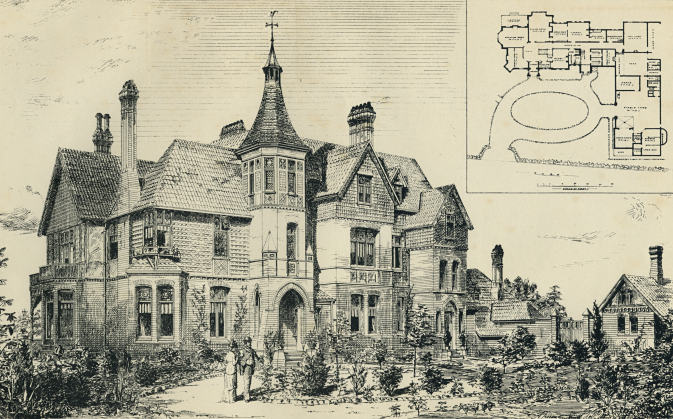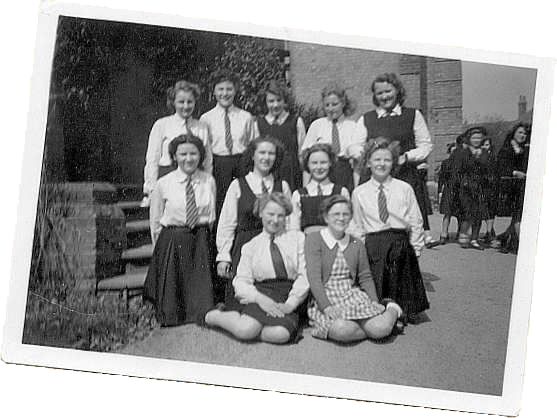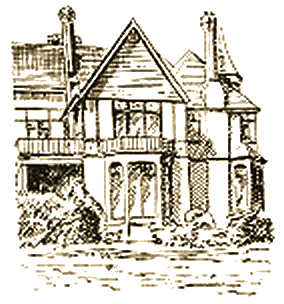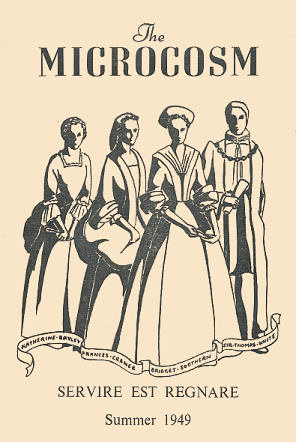|
Index...
|
 toke Park School had its beginnings in a lovely old house in Bray's Lane, built in 1879 for the Inspector of Factories, Otto Striedinger. It was called Hope's Harbour, a name synonymous with the area on which it stood for centuries. Two changes of hands later, in 1895, it came into the ownership of Lieutenant General Henry Richard Legge Newdigate, who changed the name from Hope's Harbour to Harefield in homage to his family's manors in Middlesex. Councillor George Nichols took over the property in 1902 and was to remain resident for over sixteen years. However, by 1917 talks were underway with the Education Authority to purchase the house from Mr. Nichols for use as a girls' school.
toke Park School had its beginnings in a lovely old house in Bray's Lane, built in 1879 for the Inspector of Factories, Otto Striedinger. It was called Hope's Harbour, a name synonymous with the area on which it stood for centuries. Two changes of hands later, in 1895, it came into the ownership of Lieutenant General Henry Richard Legge Newdigate, who changed the name from Hope's Harbour to Harefield in homage to his family's manors in Middlesex. Councillor George Nichols took over the property in 1902 and was to remain resident for over sixteen years. However, by 1917 talks were underway with the Education Authority to purchase the house from Mr. Nichols for use as a girls' school.
Discussions in Coventry regarding the urgent need for a "better developed system of educating girls" were aired in the Midland Daily Telegraph of 7th November 1891, so the idea was neither new nor, apparently, urgent - in fact, some dissenting voices claimed that there was "no need" for such a school! At a council meeting on Tuesday 18th December 1917 a purchase price of £4,750 was agreed, although Mr. Nichols had initially asked for £5,200 due to the amount he had spent bringing the house "up to its present state of perfection".

It was another six months before things got moving, when in July 1918 the Coventry Herald advertised an auction to sell off "A large proportion of the well-made modern furnishings of the residence", including bedroom suites, carpets, oil paintings, oak dining suites, and much more. On the 18th October 1918 Miss Helen Scott, M.A. was appointed as the first headmistress, on a salary of £300 per annum. The first five teachers were soon appointed by an Education Authority Special Committee, and at a meeting held on Wednesday 11th December they were confirmed as:
Miss S. Anderson, Miss G. M. Seelly, Miss E. Bailey, Miss M. Bumpus & Miss M. Bayley
The last two teachers on the list were to be transferred from Barrs Hill School. Their salaries ranged from £170 to £221 per annum, presumably determined by experience. They were to begin the role on the 1st January 1919 (the school year then being January to December), giving less than three weeks to prepare and find pupils for this new school!
Just four days into the school's first ever term, advertisements in local newspapers were posted asking for prospective girls to attend an entrance exam on Tuesday 14th January 1919, at 10 o'clock. The headmistress would make herself available the previous day for further information. On the 20th January 1919 the old house became home to 87 pupils at the new Stoke Park Select School for Girls.

 his house, plus a later adjoining annexe, remained their fond home until 1947, when the pupils and teachers moved to their new purpose-built school in Dane Road. The new premises had actually been built in anticipation of opening in 1939. However, the outbreak of war put that on hold and the new building was put to use temporarily as a Fire Station, manned by the Auxiliary Fire Service. From 1947 Stoke Park remained a girls' grammar school until 1975, when boys started to attend what had become a mixed comprehensive school.
his house, plus a later adjoining annexe, remained their fond home until 1947, when the pupils and teachers moved to their new purpose-built school in Dane Road. The new premises had actually been built in anticipation of opening in 1939. However, the outbreak of war put that on hold and the new building was put to use temporarily as a Fire Station, manned by the Auxiliary Fire Service. From 1947 Stoke Park remained a girls' grammar school until 1975, when boys started to attend what had become a mixed comprehensive school.
I am very fortunate to have been in touch with Muriel Wells, who used to be a pupil at Stoke Park when it was still in the house at Bray's Lane. (She has also shared her schoolday memories with us all.) My special thanks go to Muriel for giving me such useful background information about the school, including this photograph on the right, and a copy of the Microcosm school magazine, in which an ex-pupil wrote a detailed and charismatic account of the school's early days for the 1949 Summer edition, which is transcribed below. Without these, this article could not have been included on the website.
Muriel can be seen on the right hand side at the front of the small group of friends in this photo, taken near the front entrance to the Bray's Lane school in 1947, shortly before they left for Dane Road.

 hen Stoke Park Secondary School first came into being - on Tuesday, January 20th, 1919 - "Harefield," the house in Bray's Lane that was to be our School, was just as the previous owners had left it ; no alterations at all had been made to suit it to its new purpose. We were even without an adequate number of desks - with the result that, at first, we had many of our lessons sitting on the floor and on the stairs and, in better weather, on the lawns.
hen Stoke Park Secondary School first came into being - on Tuesday, January 20th, 1919 - "Harefield," the house in Bray's Lane that was to be our School, was just as the previous owners had left it ; no alterations at all had been made to suit it to its new purpose. We were even without an adequate number of desks - with the result that, at first, we had many of our lessons sitting on the floor and on the stairs and, in better weather, on the lawns.
The house itself was very large - with big rooms, well-lit by the numerous windows, and heated by open fires in the original fireplaces, which were most intriguing with their patterned tiles. The largest room - Room 2 - which ran the length of the South side - was used as our hall, and also for P.T., which we had instead of gym., since we were without any gymnastic apparatus. Although the original kitchen did still exist, we had no Domestic Science but, instead, Housewifery. Our private piano and singing lessons were given in the "tower room" at the top of the house and we played our games - which were hockey, netball and rounders - on the back lawn in the garden. In these early days the garden was a paradise. There were two huge lawns with a summer house on one and, between them, leading from a rose bower, was the well-loved dell, which we called the "Fairy Glen." In Spring both banks would be covered completely with daffodils. I cannot recall the gardens without mentioning the Siberian crab-apple tree which grew in the far corner of the lawn. How we all longed for the apples to turn their beautiful red - and how interested we were in the fig tree which grew up one of the walls!

The Headmistress was Miss Helen Scott - and she had a staff of about ten mistresses and a music master - Mr. Gibbons - for the four forms which composed the school. Form Upper II was the top form when we started and was made up of girls transferred from Barr's Hill and St. Dunstan's with one or two girls from Council Schools. For uniform we wore navy, heavily pleated tunics, with girdles, white blouses with a navy bow and black shoes, which we had to change when we entered the building. Our stockings, which were black and woollen, were worn all year since we had no summer uniform and, besides, at fourteen we were considered too old and too big to show our legs! Our hair had to be tied back - preferably in plaits. The School tie was the same as it is now - red with gold stripes - but was only worn by the girls who were in the first hockey eleven. Posture stripes were awarded for good deportment. The only school-day in the year when we escaped from uniform was Speech Day, when we all wore white dresses. Our first Speech Day was held in Bray's Lane Parish Hall.
The number of girls soon increased and, to provide more room, the "hut" was erected, and used for assembly and for gymnastics - since we now had ropes, a horse and forms. Games lessons were no longer held on the lawn, but at the C. and N.W. playing fields, and lacrosse, tennis and cricket were added to our games.
On the whole, our subjects were those that are taught to-day. "Form-time," though, was held during the last period on Friday afternoons, for all but the top form. For us, this period brought Current Events with Miss Scott, and was one to which we all looked forward. For others it was a time for self-chosen instruction and for the sharing of interests. One lower form, I remember, had a form-mistress who was a beautiful singer and during this period she would talk about the Gilbert and Sullivan operas and sing songs from them to the form. Very much a part of the school were Mr. and Mrs. Woodhouse, the caretakers. Mrs. Woodhouse took an interest in every one of us and was a mother to us all. At break it was she who gave us our milk which we could have either cold or hot.
As a school we were particularly happy. We had no set of rules ; Miss Scott insisted only that "no girl should make a nuisance of herself," which, though seemingly lenient, covers a great deal and is surely the basis of all laws and rules.
D. M. J.
In the 89 years from the opening of the school to the retirement of Bill Wolger in 2008, Stoke Park only had five headteachers:
Miss Helen Scott (1919 - 1925)
Miss Sarah W. Michell (1926 - 1947)
Miss Eileen Mary Nixon (1947 - 1972)
Miss Barbara McLauchlan (1972 - 1984)
Bill Wolger (1985 - 2008)
This, I'm sure, tells us something about how much each head enjoyed their job.
This is your first visit to my website today, thank you!
59,487Website by Rob Orland © 2025